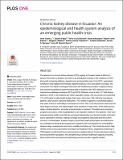Files in this item
Chronic kidney disease in Ecuador : an epidemiological and health system analysis of an emerging public health crisis
Item metadata
| dc.contributor.author | Torres, Irene | |
| dc.contributor.author | Sippy, Rachel | |
| dc.contributor.author | Bardosh, Kevin L | |
| dc.contributor.author | Bhargava, Ramya | |
| dc.contributor.author | Lotto-Batista, Martin | |
| dc.contributor.author | Bideaux, Abigail E | |
| dc.contributor.author | Garcia-Trabanino, Ramon | |
| dc.contributor.author | Goldsmith, Amelia | |
| dc.contributor.author | Narsipur, Sriram S | |
| dc.contributor.author | Stewart-Ibarra, Anna M | |
| dc.date.accessioned | 2022-09-22T16:30:11Z | |
| dc.date.available | 2022-09-22T16:30:11Z | |
| dc.date.issued | 2022-03-16 | |
| dc.identifier | 281419610 | |
| dc.identifier | 566be5fa-657b-465c-bbd3-7c3ef8549a1a | |
| dc.identifier | 85126582769 | |
| dc.identifier.citation | Torres , I , Sippy , R , Bardosh , K L , Bhargava , R , Lotto-Batista , M , Bideaux , A E , Garcia-Trabanino , R , Goldsmith , A , Narsipur , S S & Stewart-Ibarra , A M 2022 , ' Chronic kidney disease in Ecuador : an epidemiological and health system analysis of an emerging public health crisis ' , PLoS ONE , vol. 17 , no. 3 , e0265395 . https://doi.org/10.1371/journal.pone.0265395 | en |
| dc.identifier.issn | 1932-6203 | |
| dc.identifier.other | ORCID: /0000-0003-3617-2093/work/119628096 | |
| dc.identifier.uri | https://hdl.handle.net/10023/26060 | |
| dc.description | Funding: IT, AMSI, ML, SN, KB and RS were supported by a grant from Dialysis Clinic, Inc (DCI), award number 84232. | en |
| dc.description.abstract | The absence of a chronic kidney disease (CKD) registry in Ecuador makes it difficult to assess the burden of disease, but there is an anticipated increase in the incidence of CKD along with increasing diabetes, hypertension and population age. From 2012, augmented funding for renal replacement therapy expanded dialysis clinics and patient coverage. We conducted 73 in-depth sociological interviews with healthcare providers in eight provinces and collected quantitative epidemiological data on patients with CKD diagnoses from six national-level databases between 2015 and 2018. Datasets show a total of 17,484 dialysis patients in 2018, or 567 patients per million population (pmp), with an annual cost exceeding 11% of Ecuador’s public health budget. Each year, there were 139–162 pmp new dialysis patients, while doctors reported waiting lists. The number of patients on peritoneal dialysis was static; those on hemodialysis increased over time. Only 13 of 24 provinces were found to have dialysis services, and nephrologists were clustered in major cities, which limits access, delays medical attention, and adds a travel burden on patients. Prevention and screening programs are scarce, while hospitalization is an important reality for CKD patients. CKD is an emerging public health crisis that has increased dramatically over the last decade in Ecuador and is expected to continue, making coverage for all patients impossible and the current structure, unsustainable. A patient registry would help health policymakers and administrators estimate the demand and progression of patients with consideration for comorbidities, disease stage, requirements and costs, mortality and follow-up. This should be used to help identify where to focus prevention and improved treatment efforts. Organized monitoring of CKD patients would benefit from improvements in patient referral. Community-based education and prevention programs, the strengthening of primary healthcare capacity (including basic routine tests) and improved nephrology services are also urgently needed. | |
| dc.format.extent | 21 | |
| dc.format.extent | 1412994 | |
| dc.language.iso | eng | |
| dc.relation.ispartof | PLoS ONE | en |
| dc.subject | RA0421 Public health. Hygiene. Preventive Medicine | en |
| dc.subject | E-DAS | en |
| dc.subject | SDG 3 - Good Health and Well-being | en |
| dc.subject | MCC | en |
| dc.subject.lcc | RA0421 | en |
| dc.title | Chronic kidney disease in Ecuador : an epidemiological and health system analysis of an emerging public health crisis | en |
| dc.type | Journal article | en |
| dc.contributor.institution | University of St Andrews. Statistics | en |
| dc.identifier.doi | 10.1371/journal.pone.0265395 | |
| dc.description.status | Peer reviewed | en |
This item appears in the following Collection(s)
Items in the St Andrews Research Repository are protected by copyright, with all rights reserved, unless otherwise indicated.

